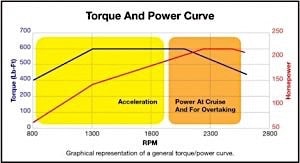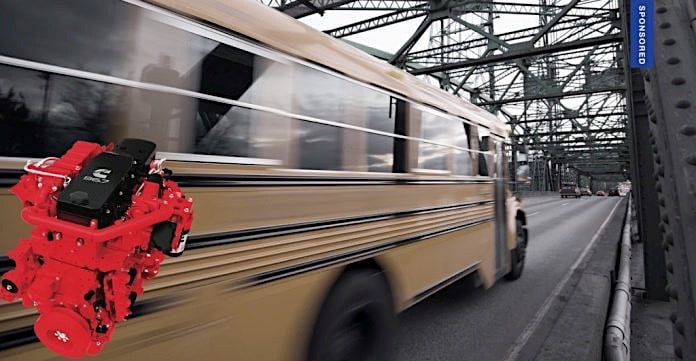When specifying engines for your buses, you will notice that the engine rating has two numbers: horsepower (200, 220, 240, 260 etc.) and torque (520, 540, 600, 660 etc.). While these are related to one another, various applications have different needs in terms of the power or torque that are required. Let’s take a deep dive into torque and why it matters for school buses.
First, what is torque? Torque is a measure of the amount of turning force needed in order to move a load. It is applied in a circular path and expressed in pound-feet (lb ft). To calculate torque, you multiply the amount of force by the distance at which the force is applied.
For example, a torque wrench could be 1 foot, 2 feet or 4 feet long. The bolt head is at the end of the wrench, and the distance for determining the torque is measured from the centerline of the bolt head to the point at which the force is applied. If you apply a force of 50 pounds at a distance of 1 foot, the equation would be: 50 lb x 1 ft = 50 lb-ft. Make that a force of 25 pounds with a 2-foot wrench, and you’d have the same result: 25 lb x 2 ft = 50 lb-ft of torque.
In countries using the metric system, torque is expressed as “Newton-meters” and abbreviated as “N•m.”
Peak Torque vs. Clutch Engagement Torque
When you look at specifications for school buses and their engines, you will commonly see two types of torque figures: peak torque and clutch engagement torque.
Peak torque is the maximum amount of rotational force that the engine can produce, and it is proportional to the amount of horsepower being generated. In general, an engine with higher horsepower ratings and a high peak torque number will be able to haul heavier loads and negotiate steep hills with greater ease than an engine with less power and torque. Municipalities with duty cycles that require more strenuous operation of the engine, need to ensure that they spec engines with the appropriate amount of power and torque to handle the requirements placed on them. This will lead to better efficiency and durability.
A key factor to look at, is how much torque is available across the entire power curve. Again, more is better. A 350-hp Cummins L9 delivers up to 1000 lb-ft of peak torque with over 800 lb-ft available from 1200-2100 rpm.
Clutch engagement torque is almost always a set point (regardless of an engine’s horsepower rating) at which the engine and transmission are “locked up” and there is no slippage. While there is not a specific Society of Automotive Engineering (SAE) standard regarding clutch engagement torque, Dana Spicer defines clutch engagement torque as being at 800 rpm.
Clutch engagement torque is a key factor in calculating startability, which allows drivers to get school buses moving forward with minimal throttle input, and to quickly and smoothly accelerate through the lower gears. It is extremely helpful on steep inclines when starting a bus from a total stop. A high startability value is a great indicator of acceleration.
Cummins B6.7 and L9 diesel engines both offer best-in-class clutch engagement torque with 400 lb-ft (542 N•m) and 500 lb-ft (746 N•m) respectively.
Pulling it all Together
Now that the different types of torque have been defined, let’s look at how torque impacts the performance and operation of a bus. There are two additional aspects that need to be addressed in terms of performance and operation, and how torque influences them: rpm and horsepower.
Torque times rpm divided by 5,252 provides a specified amount of horsepower.
This formula tells you a couple of things:
- A higher amount of torque at low rpms provides more horsepower, which helps with acceleration
- Low torque but high rpms can provide the same amount of horsepower, but at the expense of efficient engine operation
The below graph displays the output of torque and horsepower being generated across different rpm levels with reference to what portions of the curve have the greatest relationship to specific driving functions.
Torque Output, Diesel vs. Natural Gas Engines
Many municipalities are now either using or considering natural gas engines to power their school buses. One common question that comes up during the consideration process is whether they will experience a drop-off in dependability or performance in comparison to a diesel engine. Cummins Westport natural gas engines share at least 80 percent of the same heavy-duty components as Cummins diesel engines, and like the diesels, provide outstanding durability, dependability, serviceability and true diesel-like performance.
Peak torque and clutch engagement torque for natural gas engines are comparable to diesels, with virtually no perceptible difference from the driver’s standpoint.
For example, the L9N has a peak torque of 900 lb-ft at 1,300 rpm, with 700 lb-ft or more available from 1,200 to 2,100 rpm. Clutch engagement torque for the B6.7N is 295 lb-ft (400 N•m).
The chart below shows how the same displacement diesel and natural gas school bus engines compare from a torque standpoint:
| CUMMINS B6.7 DIESEL ENGINE |
CUMMINS WESTPORT B6.7N NATURAL GAS ENGINE |
CUMMINS L9 DIESEL ENGINE |
CUMMINS WESTPORT L9N NATURAL GAS ENGINE |
| 200-300 HP | 200-240 HP | 260-350 HP | 240-300 HP |
| 660 LB-FT PEAK TORQUE |
560 LB-FT PEAK TORQUE |
1000 LB-FT PEAK TORQUE |
900 LB-FT PEAK TORQUE |
| 660 LB-FT TORQUE AVAILABLE FROM 1300-2300 RPM |
560 LB-FT TORQUE AVAILABLE FROM 1500-2200 RPM |
800+ LB-FT TORQUE AVAILABLE FROM 1200-2100 RPM |
700+ LB-FT TORQUE AVAILABLE FROM 1200-2100 RPM |
| 400 LB-FT CLUTCH ENGAGEMENT TORQUE |
295 LB-FT CLUTCH ENGAGEMENT TORQUE |
550 LB-FT CLUTCH ENGAGEMENT TORQUE |
550 LB-FT CLUTCH ENGAGEMENT TORQUE |
The More Low-End Torque, the Better
Having access to a greater amount of torque at lower engine speeds enables school bus engines to operate more efficiently, and to maintain road speed with fewer downshifts, even on long mountain grades.
Learn more about Cummins diesel engines at cumminsengines.com, or visit cumminswestport.com for more information on Cummins Westport natural gas engines for the school bus market.
















